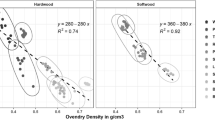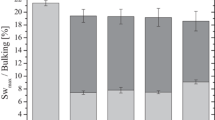Abstract
We improved the overall performance of fast-growing poplar by utilizing a low-cost, effective and simple method. The fast-growing poplar was modified by a vacuum-pressure impregnation method with three types of modification solutions composed of phenol-melamine-formaldehyde (PMF) co-condensed resin, diatomite, and 3-aminopropyl (diethoxy) methylsilane. We measured the weight percent gain (WPG), bulking, leaching, anti-swelling efficiency (ASE), water-repellent effectiveness (WRE), and oxygen index of the modified specimens. All of the wood physical properties, which are beneficial for human uses, were significantly improved by the treatment. We improved various characteristics of wood and the oxygen index of poplar above 48.6% after the modification using diatomite and PMF co-condensed resin.
Similar content being viewed by others
References
Al-Degs YS, Khraisheh MAMM, Tutunji MF. 2001. Sorption of lead ions on diatomite and manganese oxides modified diatomite. Water Research, 35(15): 3724–3728.
Cai XL, Riedl B, Wan H, Zhang SY, Wang XM. 2010. A study on the curing and viscoelastic characteristics of melamine-urea-formaldehyde resin in the presence of aluminium silicate nanoclays. Composites Part A: Applied Science and Manufacturing, 41(5): 604–611.
Devi RR, Maji TK. 2008. Chemical modification of rubber wood with styrene and glycidyl methacrylate. Polymer Composites, 29(11): 1258–1261.
Devi RR, Maji TK. 2012. Chemical modification of simul wood with styrene-acrylonitrile copolymer and organically modified nanoclay. Wood Science and Technology, 46(1–3): 299–315.
Furunot, Goto T. 1979. Structure of the interface between wood and synthetic polymer (XII): Distribution of styrene polymer in the cell wall of wood-polymer composite (WPC) and dimensional stability. Mokuzai Gakkaishi, 25(7): 488–495.
Gu JY. 1999. Adhesive and coating. Beijing: China Forestry Publishing House.
Imamura H, Okamoto H, Goto T. 1983. Chemistry for Wood Utilization. Tokyo: Kyoritsu Shuppan, pp. 261–262.
Imamura Y, Kajita H, Higuchi N. 1998. Modification of wood by treatment with low molecular phenol-formaldehyde resin (I): Influence of neutral and alkaline resins. Japan Wood Research Society. Shizuoka, Japan: The 48th Annual Meeting of the Japan Wood Research Society.
Kajita H, Imamura Y. 1991. Improvement of physical and biological properties of particleboards by impregnation with phenolic resin. Wood Science and Technology, 6(1): 63–70.
Khraisheh MAM, Al-degs YS, Mcminn WAM. 2004. Remediation of wastewater containing heavy metals using raw and modified diatomite. Chemical Engineering Journal, 99(2): 177–184.
Khraisheh MAM, Al-Ghouti MA, Allen SJ, Ahmad MN. 2005. Effect of OH and silanol groups in the removal of dyes from aqueous solution using diatomite. Water Research, 39(5): 922–932.
Li J, Wang CY. 2010. Preparation of hydrophobic and oleophobic wood/calcium carbonate compound material in situ with the method of bionic mineralization. China. Invention. CN 101797762 A.
Li JZ, Zhou WR, Zhang DR. 2003. The base and theoretic mode of wood modification. International Wood Industry, 3: 17–19.
Ogiso K, Saka S. 1994. Wood-inorganic composites prepared by the sol-gel process IV: effects of chemical bends between wood and inorganic substances on property enhancement. Mokuzai Gakkaishi, 40(10): 1100–1106.
Ryu JY, Imamura Y, Takahashim, Kajita H. 1993. Effects of molecular weight and some other properties of resins on the biological resistance of phenolic resin treated wood. Journal of the Japan Wood Research Society, 39(4): 486–492.
Saka S, Tanno F. 1996. Wood-inorganic composites prepared by the sol-gel process VII: effects of a property-enhance on fire-resistance in SiO2-P2O5 and SiO2-B2O3 wood-inorganic composites. Mokuzai Gakkaishi, 42(1): 81–86.
Şan O, Gören R, Özgür C. 2009. Purification of diatomite powder by acid leaching for use in fabrication of porous ceramics. International Journal of Mineral Processing, 93(1): 6–10.
Shi JS, Li JZ, Zhou WR, Zhang DR. 2006. Improvement of wood properties by urea-formaldehyde resin and nano-SiO2. Journal of Beijing Forestry University, 28(2): 123–128.
Song ZM. 2008. The Researeh on “Phenol-Melamine-Formaldehyde” Co-condensed resin. China, Changsha: Central South University.
Takeshi F, Kwnta S, Tohru U. 1992. Combination of wood and silicate II: wood-mineral composites using water glass and reactants of barium chloride, boric acid, and borax, and their properties. Mokuzai Gakkaishi, 38(5): 448–457.
Takeshi F, Tohru U, Susumu J. 1991. Combination of wood and silicate I: impregnation by water glass and application of aluminum sulphate and calcium chloride as reactants. Mokuzai Gakkaishi, 37(5): 462–472.
Takeshi F, Tohru U. 1993. Combination of wood and silicate III: some properties of wood-mineral composites using the water glass-boron compound system. Mokuzai Gakkaishi, 39(5): 561–570.
Yu XC, Sun DL, Li XS. 2011. Preparation and characterization of urea-formaldehyde resin-sodium montmorillonite intercalation-modified poplar. Journal of Wood Science, 57(6): 501–506.
Author information
Authors and Affiliations
Corresponding author
Additional information
Fund project: This research was supported by Program for New Century Excellent Talents in University (NCET-10-0311), the National Natural Science Foundation of China (31000271) and the Fundamental Research Funds for the Central Universities (DL11BB29)
Rights and permissions
About this article
Cite this article
Zhang, M., Xu, Y., Wang, Sl. et al. Improvement of wood properties by composite of diatomite and “phenol-melamine-formaldehyde” co-condensed resin. Journal of Forestry Research 24, 741–746 (2013). https://doi.org/10.1007/s11676-013-0413-2
Received:
Accepted:
Published:
Issue Date:
DOI: https://doi.org/10.1007/s11676-013-0413-2




